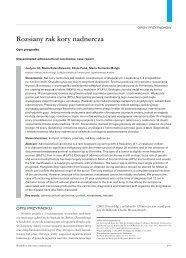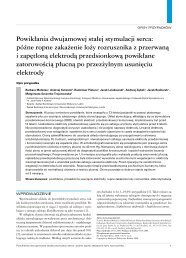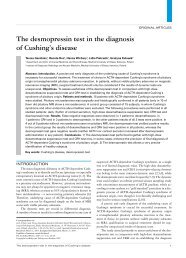Wegener's granulomatosis effectively treated with rituximab: a case ...
Wegener's granulomatosis effectively treated with rituximab: a case ...
Wegener's granulomatosis effectively treated with rituximab: a case ...
Create successful ePaper yourself
Turn your PDF publications into a flip-book with our unique Google optimized e-Paper software.
Wegener’s <strong>granulomatosis</strong> <strong>effectively</strong> <strong>treated</strong><br />
<strong>with</strong> <strong>rituximab</strong>: a <strong>case</strong> study<br />
Bożena Kowalewska 1 , Jacek Szechiński 2 , Eliza Roszkowska 1<br />
1 Department of Rheumatology and Internal Diseases of the University Clinical Hospital, Wrocław, Poland<br />
2 Chair and Department of Rheumatology, Medical University, Wrocław, Poland<br />
INTRODUCTION<br />
Wegener’s <strong>granulomatosis</strong> (WG) is a necrotizing inflammation<br />
of small and medium-sized vessels, upper and lower<br />
airways and kidneys, characterized by granulomas formation<br />
and presence of cytoplasmic antineutrophil cytoplasmic antibodies<br />
(cANCA) [1].<br />
In 95–99% patients <strong>with</strong> active and in 65% of patients<br />
<strong>with</strong> inactive forms of this disease, the presence of cANCA<br />
antibodies has been observed. Their titre correlates <strong>with</strong> the<br />
severity of the disease and response to treatment [2].<br />
Besides the classic triad of the involved organs specified in<br />
the definition, otitis <strong>with</strong> progressive hearing loss [3], involve-<br />
Correspondence to:<br />
Bożena Kowalewska, MD, PhD, Oddział Kliniczny Kliniki Reumatologii, Akademia<br />
Medyczna, ul. Bo rowska 213, 53-138 Wrocław, Poland, phone/fax: +48-71-734-33-90,<br />
e-mail: bkhematol@wp.pl<br />
Received: February 22, 2008. Accepted in final form: April 15, 2008.<br />
Conflict of interest: none declared.<br />
Pol Arch Med Wewn. 2008; 118 (6): 381-385<br />
Translated by Professional Language Services SIGILLUM Ltd., Kraków<br />
Copyright by Medycyna Praktyczna, Kraków 2008<br />
CASE REPORTS<br />
Abstract: Wegener’s <strong>granulomatosis</strong> (WG) is a granulomatous disorder associated <strong>with</strong> systemic necrotizing<br />
vasculitis. Wegener’s <strong>granulomatosis</strong> predominantly involves the upper airways, lung and kidneys. The disease<br />
is often associated <strong>with</strong> cytoplasmic antineutrophil cytoplasmic antibodies (cANCA). B lymphocytes are potential<br />
cANCA producers and there is an evident correlation between cANCA titre, severity of the disease and response<br />
to treatment. Wegener’s <strong>granulomatosis</strong> usually begins <strong>with</strong> symptoms limited mostly to the upper and/or lower<br />
respiratory tracts and may transform into the generalized phase, characterized by systemic necrotizing vasculitis.<br />
If left un<strong>treated</strong>, it can turn fulminant <strong>with</strong> poor prognosis. The severe form of the disease is usually <strong>treated</strong> <strong>with</strong><br />
a combination of cyclophosphamide and corticosteroids. In refractory <strong>case</strong>s, <strong>rituximab</strong> that binds to CD20<br />
expressed on B-cells should be considered. We presented a <strong>case</strong> of a 38-year-old woman <strong>with</strong> severe form<br />
of WG, refractory to standard therapy. Despite the standard treatment <strong>with</strong> cyclophosphamide and<br />
corticosteroids and the addition of infliximab <strong>with</strong> methotrexate, progression of the disease was observed.<br />
Exacerbation affected mainly the lungs and caused the gradual destruction of pulmonary tissue and<br />
development of respiratory insufficiency. Rituximab (500 mg) was given intravenously every week in four<br />
infusions, causing a partial remission of WG and the arrest of lung deterioration. The following administration of<br />
500 mg was given every two weeks, which induced the remission of WG and enabled the patient to return to her<br />
normal activity and work. Such treatment appeared to be successful and prevented severe pulmonary<br />
involvement.<br />
Key words: anti-CD20 antibodies, cytoplasmic antineutrophil cytoplasmic antibodies, <strong>rituximab</strong>, Wegener’s<br />
<strong>granulomatosis</strong><br />
ment of the eyeballs, frequently their protrusion [4], skin, nervous<br />
system, joints or mucous membranes are also observed.<br />
Diagnosing limited or generalised (severe) forms of WG<br />
is crucial for proper therapeutic management. In the limited<br />
form, life-threatening symptoms or severe damage of life-sustaining<br />
organs are not present, while in the severe form a significant<br />
impairment of the functioning of many vital organs<br />
is observed.<br />
In the limited form, combined treatment <strong>with</strong> glucocorticosteroids<br />
(GS) <strong>with</strong> trimethoprim + sulphamethoxazole or<br />
GS <strong>with</strong> methotrexate is used.<br />
The severe form of WG is conventionally <strong>treated</strong> <strong>with</strong> cyclophosphamide<br />
in the form of intravenous infusions every<br />
month, or oral doses of 2 mg/kg/24 h, <strong>with</strong> prednisone in<br />
doses of 1 mg/kg/24 h. The treatment is performed until a<br />
remission occurs. Subsequent to maintenance treatment, cyclophosphamide<br />
can be replaced <strong>with</strong> methotrexate, azathioprine<br />
and mycophenolate mofetil.<br />
In severe forms of WG, resistance to therapy <strong>with</strong> cyclophosphamide<br />
and prednisone is frequently observed. “Refractory”<br />
disease is a state in which the recurrence of symptoms in<br />
WG patients obtaining maximal tolerable doses of cyclophos-<br />
Wegener’s <strong>granulomatosis</strong> <strong>effectively</strong> <strong>treated</strong> <strong>with</strong> <strong>rituximab</strong>: a <strong>case</strong> study 381
CASE REPORTS<br />
Fig. 1. Lung lesions on chest X-ray (October 2005) Fig. 2. Regression of lung abnormalities after the completion of the<br />
first cycle of <strong>rituximab</strong> therapy (January 2006)<br />
phamide is observed, or for which contraindications to repeat<br />
the courses of cyclophosphamide (cytopenias, hemorrhagic cystitis,<br />
cancers) exist [5]. Biological medications, mainly <strong>rituximab</strong>,<br />
are successfully used in resistant forms of antineutrophil<br />
cytoplasmic antibodies (ANCA) associated vasculitis, not only<br />
including WG, but also the microscopic vasculitis [6,7].<br />
Rituximab is a chimeric human-mice monoclonal antibody<br />
directed against CD20 surface marker, localised on pre-B<br />
lymphocytes, normal and neoplastically transformed mature<br />
B lymphocytes. Rituximab was registered for the first time in<br />
the United States in 1997 for the therapy of malignant non-<br />
Hodgkin’s lymphomas, and in Europe in 1998. The medication<br />
is also successfully used in patients <strong>with</strong> rheumatoid arthritis,<br />
idiopathic thrombocytopenic purpura, hemolytic anemia,<br />
and in patients <strong>with</strong> vasculitis.<br />
The following is the <strong>case</strong> of female patient <strong>with</strong> a severe,<br />
recurrent form of WG <strong>with</strong> cANCA antibodies, refractory<br />
to standard therapy <strong>with</strong> cyclophosphamide and prednisone,<br />
<strong>with</strong> no response to therapy by infliximab and methotrexate.<br />
Rituximab appeared to be successful.<br />
CASE REPORT<br />
The first symptoms in this 38-year-old woman appeared<br />
at the beginning of January 2004 – putrid purulent rhinitis,<br />
progressive loss of body mass (loss of about 18 kg <strong>with</strong>in 3<br />
months), progressive hearing loss in the left ear, a high fever,<br />
hoarseness, and generalized joint pain, especially in the<br />
elbow, knee and iliac joints were observed. In the chest X-ray<br />
examination non-specific infiltrations in the lungs were ob-<br />
served. The patient was unsuccessfully <strong>treated</strong> <strong>with</strong> numerous<br />
antibiotics.<br />
In March 2004 she was admitted to the Clinic of Rheumatology<br />
of the Medical Academy in Wrocław, where a diagnosis<br />
of Wegener’s <strong>granulomatosis</strong> was made on the basis<br />
of the above clinical symptoms, purulent necrotizing lesions<br />
on the mucous membrane of the nasopharynx, sinusitis, otitis<br />
media of the left ear, lesions in the lungs and the following<br />
abnormalities in laboratory tests such as high activity of inflammatory<br />
parameters: erythrocyte sedimentation rate (ESR)<br />
– 86 mm/h, C-reactive protein (CRP) – 5.8 mg%, fibrinogen<br />
526 mg%, significant increase of the cANCA antibodies levels<br />
(PR3: 196.4 RU/ml; norm to 15 RU/ml), anemia (Hb value<br />
– 10.4 g%), secondary thrombocytosis (platelet count of<br />
704 G/l), presence of protein in the urine.<br />
Treatment <strong>with</strong> trimethoprim + sulphamethoxazole, glucocorticosteroids<br />
and cyclophosphamide was implemented.<br />
From March to November 2004, the patient received 9 infusions<br />
of cyclophosphamide for 800 mg every 3–4 weeks and<br />
prednisone orally in doses of 20–40 mg/24 h. After this therapy<br />
only a transient clinical improvement <strong>with</strong> normalization<br />
of laboratory parameters – CRP and cANCA (PR3: 12.1<br />
RU/ml) – was obtained and significant decrease of ESR to 26<br />
mm/h was observed.<br />
Since September 2004, an exacerbation of clinical symptoms<br />
and increase in activity of inflammatory parameters<br />
have been observed, and on computed tomography of the<br />
chest the presence of 5 tumors, 2.4 cm in diameter <strong>with</strong> visible<br />
air space, have been found.<br />
382 POLSKIE ARCHIWUM MEDYCYNY WEWNĘTRZNEJ 2008; 118 (6)
ESR<br />
(mm/h)<br />
100<br />
75<br />
50<br />
25<br />
0<br />
2004<br />
86<br />
27<br />
196.4<br />
72<br />
In the face of the exacerbation of the disease, in December<br />
2004 the decision was made for implementation of therapy<br />
<strong>with</strong> infliximab.<br />
Until September 2005, 200 mg of infliximab (altogether 6<br />
infusions) were coadministered <strong>with</strong> methotrexate at a dose<br />
of 15 mg/week and methylprednisolone in oral doses of 12<br />
mg/24 h, <strong>with</strong>out significant improvement.<br />
Due to the symptoms exacerbation in form of fever, exacerbation<br />
of purulent lesions in the nasopharynx, appearance<br />
of purulent necrotizing lesions on toes of both feet, increasing<br />
dyspnea connected <strong>with</strong> significant progression of tuberous<br />
changes in the lungs (Fig. 1), increase of activity of inflammatory<br />
the parameters (ESR – 80 mm/h, CRP – 17.2 mg%) and<br />
cANCA antibodies (PR3 – 39.3 RU/ml), the decision to use<br />
<strong>rituximab</strong> was made.<br />
In the period between November and December 2005,<br />
4 infusions of <strong>rituximab</strong> in doses of 500 mg each were administered<br />
every week in 4-hour infusions. Each <strong>rituximab</strong><br />
administration was preceded by a methylprednisolone infusion<br />
in doses of 500 mg. In the period between the infusions,<br />
methylprednisolone was administered in doses of 24 mg/24 h.<br />
In January 2006 – one month after the completion of the<br />
treatment – an evaluation of treatment was carried out; sig-<br />
80<br />
12.1<br />
86<br />
11.3<br />
80<br />
90<br />
48<br />
2005 2006 2008<br />
Cyclofosfamide Inflixmab RTX<br />
4 × 500 mg<br />
46<br />
5.6<br />
CASE REPORTS<br />
Fig. 3. Charts of erythrocyte sedimentation rate (ESR) and cytoplasmic antineutrophil cytoplasmic antibodies (cANCA) values during the<br />
treatment of resistant Wegener’s <strong>granulomatosis</strong>. Abbreviations: GS – glucocorticosteroids, RTX – <strong>rituximab</strong><br />
nificant subjective improvement, normalization of inflammatory<br />
parameters (ESR – 16 mm/h, CRP – 0.9 mg%) and blood<br />
morphology parameters (Hb – 14.2 g%, leukocytes – 13,900,<br />
platelets 257 G/l), improvement of lung functions in spirometry<br />
and normalization of ANCA value (PR3: 5.634 RU/ml),<br />
significant regression of changes in both lungs (Fig. 2) and<br />
partial regression of lesions in sinuses were observed.<br />
The complete remission of disease at 8 mg of methylprednisolone<br />
only was maintained by the end of September 2006<br />
(10 months after the <strong>rituximab</strong> infusion).<br />
The patient’s condition was stable by October 2006, when<br />
hemoptysis, periodic fever, joint pain and malaise occurred.<br />
An increase of the ESR value to 56 mm/h and cANCA value<br />
to 43.7 RU/ml was observed. It was decided to implement<br />
the subsequent therapy <strong>with</strong> <strong>rituximab</strong>; the medication<br />
was administered in December 2006 (two administrations of<br />
medicine, 500 mg each at interval of 14 days).<br />
The next administration of medication took place in June<br />
2007 (2 administrations for 500 mg). Since then patient’s<br />
general state was good, she returned to work and used only<br />
8 mg/24 h of methylprednisolone. In the beginning of February<br />
2008 the patient underwent check-ups, which revealed<br />
clinical and laboratory remission (ESR – 11 mm/h, cANCA –<br />
Wegener’s <strong>granulomatosis</strong> <strong>effectively</strong> <strong>treated</strong> <strong>with</strong> <strong>rituximab</strong>: a <strong>case</strong> study 383<br />
36<br />
7.4<br />
56<br />
43.7<br />
RTX<br />
2 × 500 mg<br />
23<br />
76<br />
23.4 11<br />
RTX<br />
2 × 500 mg<br />
10.9<br />
RTX<br />
2 × 500 mg<br />
GS GS GS GS GS GS<br />
cANCA<br />
ESR<br />
cANCA<br />
(RU/ml)<br />
200<br />
150<br />
100<br />
50<br />
0
CASE REPORTS<br />
10.9 RU/ml) and further reduction of pulmonary lesions on<br />
computed tomography. To maintain the remission, 2 more<br />
<strong>rituximab</strong> infusions of 500 mg each <strong>with</strong> 14-day intervals<br />
were administered.<br />
Figure 3 presents charts of ESR and cANCA values over<br />
the course of disease and the medications used.<br />
DISCUSSION<br />
This <strong>case</strong> of a female patient <strong>with</strong> WG <strong>with</strong> cANCA antibodies<br />
is characterized by an unusually strong activity of disease<br />
and resistance to a 9-month therapy <strong>with</strong> cyclophosphamide.<br />
This cytostatic agent is still the most effective medication<br />
used in therapy of vasculitis <strong>with</strong> ANCA antibodies.<br />
The mechanism of its action depends on selective suppression<br />
of immunoglobulin production by lymphocytes B. Ten percent<br />
of WG patients show resistance to conventional therapy<br />
<strong>with</strong> cyclophosphamide, and these patients require intensive<br />
treatment <strong>with</strong> new generation drugs that are monoclonal<br />
antibodies.<br />
The lack of response to therapy <strong>with</strong> infliximab in combination<br />
<strong>with</strong> methotrexate suggests that proinflammatory cytokines,<br />
such as tumor necrozing factor, do not play an important<br />
role in patomechanism of WG. An analysis of literature<br />
[8] shows, that lymphocytes B and their product – cANCA –<br />
play more important role in the mechanisms of this disease,<br />
as the level of these antibodies visibly correlates <strong>with</strong> the disease’s<br />
activity.<br />
Taking into consideration data from the literature and the<br />
severe, life-threatening course of the disease in the <strong>case</strong> of our<br />
patient, the decision was made to implement <strong>rituximab</strong>. The<br />
first administration of the medication was performed according<br />
to the scheme presented by Kallenbach et al. [9], in the<br />
form of 4 infusions of 500 mg of the medication in combined<br />
therapy <strong>with</strong> weekly glucocorticosteroids.<br />
The full remission of the disease confirmed the effectiveness<br />
of this therapy, which has been described by other authors<br />
[7-10].<br />
The remission lasted 10 months, which can be explained by<br />
the regeneration of lymphocytes B in this period.<br />
The number of peripheral lymphocytes B directly after the<br />
<strong>rituximab</strong> administration is practically indeterminable, after<br />
6 months it gradually increases, and after an average of 11<br />
months it obtains a normal value.<br />
Taking into consideration that each exacerbation of the disease<br />
in our patient caused further gradual destruction of pulmonary<br />
tissue and development of respiratory insufficiency, the decision<br />
to administrate <strong>rituximab</strong> every 6 months in half dosages<br />
(2 × 500 mg) was made. Consequently, doses of medication<br />
were administered every 6 months according to the pattern for<br />
rheumatoid arthritis patients <strong>treated</strong> <strong>with</strong> <strong>rituximab</strong> in clinical<br />
trials, i.e. 2 infusions for 500 mg in 14-day intervals [11].<br />
The therapy appeared to be effective, and after 3 therapeutic<br />
courses clinical and laboratory remission and reduction of<br />
pulmonary changes were achieved.<br />
Rituximab appears to be very effective medication in resistant,<br />
severe forms of WG. Taking into consideration that<br />
the medication does not cause severe side effects or infectious<br />
complications, its usefulness in therapy for severe forms<br />
of WG may be greater than cyclophosphamide, which causes<br />
multiple side effects.<br />
REFERENCES<br />
1. Szczeklik A, Musiał J. Układowe zapalenia naczyń. Ziarniniakowatość Wegenera. In:<br />
Szczeklik A, ed. Choroby wewnętrzne. T. 2, Kraków, Medycyna Praktyczna, 2006:<br />
1687-1690.<br />
2. Zimmermann-Górska I, Puszczewicz M. Badania diagnostyczne. Przeciwciała przeciwko<br />
cytoplazmie neutrofilów. In: Szczeklik A, ed. Choroby wewnętrzne. T. 2,<br />
Kraków, Medycyna Praktyczna, 2006: 1620-1621.<br />
3. Dębski MG, Życińska K, Czarkowski M, et al. Postępująca utrata słuchu jako wiodący<br />
objaw ziarniniakowatości Wegnera. Pol Arch Med Wewn. 2007; 117: 266-269.<br />
4. Majewski D, Puszczewicz M, Zimmermann-Górska I, et al. Przebieg ziarniniaka<br />
Wegnera z zajęciem gałki ocznej – opis przypadku. Pol Arch Med Wewn. 2006; 115:<br />
243-247.<br />
5. Antoniu SA. Rituximab for refractory Wegener’s <strong>granulomatosis</strong>. Expert Opin<br />
Investig Drugs. 2006; 9: 1115-1117.<br />
6. Omdal R, Wildhagen K, Hansen T, et al. Anti-CD 20 therapy of treatment-resistant<br />
Wegener’s <strong>granulomatosis</strong>: favourable but temporary response. Scand J Rheumatol.<br />
2005; 34: 229-232.<br />
7. Ferraro AJ, Day CJ, Drayson MT, et al. Effective therapeutic use of <strong>rituximab</strong> inrefractory<br />
Wegener’s <strong>granulomatosis</strong>. Nephrol Dial Transplant. 2005; 20: 622-625.<br />
8. Keogh KA, Wylam ME, Stone JH, et al. Induction of remission by B lymphocyte<br />
depletion in eleven patients <strong>with</strong> refractory antineutrophil cytoplasmic antibodyassociated<br />
vasculitis. Arthritis Rheum. 2005; 52: 262-268.<br />
9. Kallenbach M, Duan H, Ring T. Rituximab induced remission in a patient <strong>with</strong><br />
Wegener’s <strong>granulomatosis</strong>. Nephron Clin Pract. 2005; 99: 92-96.<br />
10. Eriksson P. Nine patients <strong>with</strong> anti-neutrophil cytoplasmic antibody-positive vasulitis<br />
successfully <strong>treated</strong> <strong>with</strong> <strong>rituximab</strong>. J Int Med. 2005; 257: 540-548.<br />
11. Edwards JC, Szczepanski L, Szechinski J, et al. Efficacy of B-cell-targeted therapy<br />
<strong>with</strong> <strong>rituximab</strong> in patients <strong>with</strong> rheumatoid arthritis. N Engl J Med. 2004; 350:<br />
2572-2581.<br />
384 POLSKIE ARCHIWUM MEDYCYNY WEWNĘTRZNEJ 2008; 118 (6)







